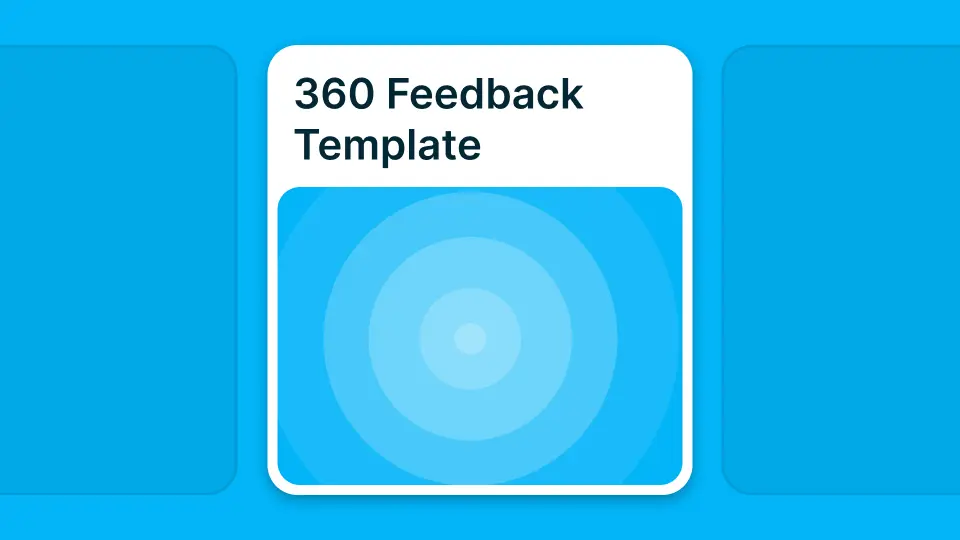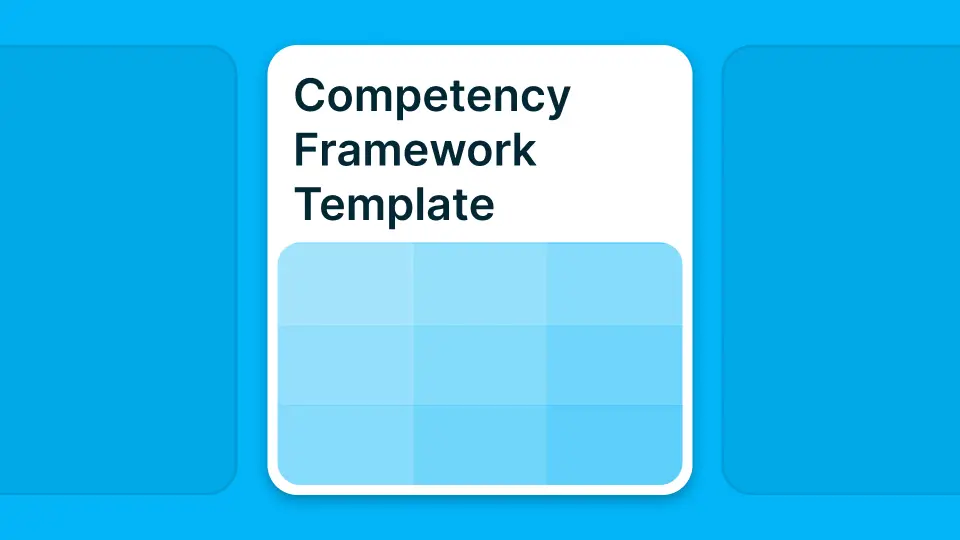Most leadership teams walk out of talent reviews with scattered notes, unclear action items, and frustrated managers wondering what just happened. Here's a sobering reality: structured talent review meetings with clear templates can cut decision-making time by 40% while improving promotion fairness by nearly 20%. This post delivers exactly what you need—downloadable agendas, slide decks, and nine-box boards that transform chaotic discussions into strategic workforce planning sessions.
You'll get immediate access to copy-ready templates for 60, 90, and 120-minute meetings, complete with calibration workflows, bias mitigation prompts, and compliance-ready documentation. Whether you're running your first talent review or refining an existing process, these tools help you prep smarter, facilitate better, and follow up with clarity.
- Ready-to-use Google Docs agendas and PowerPoint slide decks
- Printable and digital nine-box boards for live mapping
- Step-by-step checklists covering pre-work through post-meeting follow-up
- Practical examples from companies that reduced talent gaps by 30% year-over-year
- Governance frameworks for GDPR compliance and works council requirements
Let's start with what makes a talent review meeting worth everyone's time—and which artifacts you actually need to run one well.
1. What Makes Talent Review Meetings Strategic (Not Just Another Calendar Block)
Talent review meetings are structured conversations where leadership teams assess employee performance, potential, and succession risks using standardized criteria. Done right, they create clarity on who's ready for what—and who needs support to get there. The alternative? Ad-hoc decisions driven by whoever speaks loudest in the room.
A SHRM study found companies with structured talent reviews are twice as likely to meet leadership pipeline goals. Yet 70% of HR leaders admit their informal reviews lead to inconsistent promotion decisions, according to LinkedIn Talent Trends data. That's not a small gap—it's a systematic failure to turn conversations into outcomes.
Consider a global software company with 2,000 employees that shifted from informal check-ins to agenda-driven reviews. Within one year, they cut critical talent gaps by 30% and reduced time-to-fill for senior roles by three weeks. The difference wasn't magic—it was structure.
- Clarify business objectives before scheduling the meeting—succession planning requires different prep than performance calibration
- Involve cross-functional leaders to prevent siloed thinking and uncover hidden high performers
- Use standardized criteria like BARS (Behaviorally Anchored Rating Scales) to anchor subjective judgments in observable behaviors
- Track every decision with shared logs accessible to all participants—no "he said, she said" after the fact
- Link discussion points directly to succession planning templates and individual development plans
| Objective | Old Approach | Structured Review Outcome |
|---|---|---|
| Identify successors | Ad-hoc nominations based on visibility | Evidence-based selection using nine-box grids |
| Address skill gaps | Untracked assumptions about training needs | Action plans with specific owners and deadlines |
| Promotion decisions | Manager bias and recency effects | Group-calibrated recommendations with documented rationale |
One more thing: use the same template across business units. Regional variations create comparison headaches during enterprise-wide calibration sessions. Now that the purpose is locked in, let's build an agenda that keeps everyone focused.
2. Talent Review Meeting Agenda Templates: Structure That Prevents Rambling
A clear agenda—whether for a 60-, 90-, or 120-minute session—keeps discussions focused and ensures all critical topics get covered without overrunning. Harvard Business Review notes meetings with predefined agendas are 40% more likely to produce actionable next steps. Yet only 28% of managers feel confident leading reviews without one, according to an HR.com survey.
A mid-size biotech firm adopted our Google Docs agenda template for quarterly reviews. Post-meeting surveys showed a 25% boost in perceived fairness and transparency—managers knew what to expect, and HR could redirect tangents back to agenda items.
- Set clear objectives at the top of your agenda—are you calibrating ratings, identifying flight risks, or both?
- Allocate time blocks per topic: 20 minutes for performance calibration, 15 for potential assessment, 10 for succession risks
- Build in DEI checkpoints after each segment to catch patterns before finalizing decisions
- Reserve final 5-10 minutes for action items and documentation—who owns what by when
- Share the agenda 48 hours ahead of time so participants can pre-align on contentious cases
| Segment | Duration | Owner |
|---|---|---|
| Welcome and goals | 10 min | HR Lead |
| Calibration inputs review | 20 min | Managers |
| Nine-box board mapping | 20 min | Facilitator |
| Succession risk discussion | 15 min | Leadership |
| DEI fairness check | 10 min | HR/Facilitator |
| Next steps and action items | 5 min | All |
For shorter 60-minute meetings, compress calibration and nine-box mapping into a single 25-minute block. For 120-minute sessions with multiple teams, add 15-minute breaks after the first hour. The key is respecting time limits—calibration discussions expand to fill available space if you let them.
Download our free agenda templates in Google Docs format to customize for your organization's needs. With your agenda locked in, let's look at how pre-work sets the stage for a productive session.
3. Pre-Work Checklist: Setting Up for Evidence-Based Discussions
Prepping the right data—draft reviews, OKRs, feedback summaries—ensures a fact-based discussion and prevents last-minute scrambling. Gartner research shows teams using pre-work checklists spend half as much time debating ratings because they've already aligned on evidence.
Teams who complete structured pre-work increase review efficiency by up to 35%. A fintech startup rolled out a pre-meeting checklist that included reviewing BARS rubrics and recent peer feedback. Their calibration scores aligned more closely with actual job performance over two cycles, and they eliminated post-meeting appeals about "surprises."
- Gather draft performance evaluations from all managers at least three days before the meeting
- Pull recent OKR progress and project outcomes—deliverables speak louder than opinions
- Include summaries from recent one-on-one notes to capture context that formal reviews miss
- Compile relevant feedback from 360-degree reviews, peer assessments, and customer interactions
- Distribute BARS rubrics ahead of time so everyone calibrates against the same behavioral anchors
| Pre-Work Item | Responsible Party | Due Date |
|---|---|---|
| Draft performance reviews | Managers | T-3 days |
| OKR updates and deliverables | Employees | T-4 days |
| Feedback summaries (360°, peer) | HR | T-2 days |
| BARS rubric distribution | HR | T-5 days |
| Nine-box draft placements | Managers | T-2 days |
Share this checklist via collaborative tools like Google Sheets or Microsoft Teams so everyone can track completion status. One European retailer added a "pre-work completed" column to their meeting invite—attendance dropped by zero, but prep quality jumped 40%.
Don't skip the BARS rubrics step. Without shared definitions of "exceeds expectations," you'll spend half the meeting arguing about semantics instead of substance. Once you're set up with robust data inputs, structuring your slide deck becomes straightforward.
4. Building Your Talent Review Slide Deck: Sections That Drive Decisions
A well-designed slide deck isn't just pretty—it anchors discussion points around evidence and aligns everyone on next steps. Josh Bersin research shows that templated decks improve meeting consistency by over 30%. Organizations using standard decks report a 20% increase in decision-making speed, according to Bersin by Deloitte.
At a retail chain with decentralized stores, introducing PowerPoint slide templates helped unify rating language across regions. Regional managers reported fewer miscommunications and faster consensus on cross-regional talent moves afterward.
- Section slides for calibration inputs with summary charts showing rating distributions by team
- Include visualized nine-box grids by function, team, or business unit for easy comparison
- Dedicated slides for succession risk analysis highlighting single points of failure
- Spotlight DEI metrics after each major section—gender, ethnicity, age distributions by rating
- End with decision logs and action items tracker showing owner, deadline, and status
| Slide Section | Purpose | Owner |
|---|---|---|
| Calibration summary | Align on performance inputs and rating distributions | HR |
| Nine-box views | Visualize talent spread and identify high-potential employees | Team Leads |
| Succession risks | Identify critical roles with no ready successors | Leadership |
| DEI fairness check | Surface potential bias patterns before finalizing decisions | HR/Facilitator |
| Action items log | Document next steps with clear ownership and deadlines | All |
Keep your deck to 15-20 slides maximum for a 90-minute meeting. Each slide should spark discussion, not be read verbatim. One global logistics company used a "parking lot" slide at the end to capture off-topic items worth revisiting later—it saved 20 minutes per session.
Templates are available in both Google Slides and PowerPoint formats for easy customization. Now let's see how the nine-box matrix brings it all together visually.
5. Using the Nine-Box Board Effectively: Mapping Performance and Potential
The nine-box matrix is more than just a grid—it helps teams visualize performance versus potential objectively and spot hidden stars or flight risks. CEB/Gartner found that companies using nine-box boards reduce promotion bias by up to 18%. Fifty-two percent of organizations say the nine-box matrix is their go-to tool for high-potential identification.
An international logistics provider used printout versions during remote sessions so every manager could actively participate by moving sticky notes in real time. They later digitized results into Google Sheets for tracking over time—managers could see how employees moved across boxes quarter-over-quarter.
- Print or share digital copies for every participant—passive observers miss context
- Color-code boxes by risk or readiness level: red for flight risks, green for promotion-ready, yellow for development-needed
- Add employee initials only during discussion—avoid full names to mitigate unconscious bias
- Update after every cycle to track movement and progress toward development goals
- Link board outcomes directly to individual development plans and succession planning templates
| Box Position | Typical Profile | Development Focus |
|---|---|---|
| High Performance / High Potential | Emerging leader ready for stretch roles | Succession planning and executive coaching |
| High Performance / Medium Potential | Consistent performer in current role | Stretch assignments and skill expansion |
| Low Performance / High Potential | New hire or recent role change | Onboarding support and quick wins |
| Medium Performance / Medium Potential | Solid contributor needing clarity | Career path conversations and skill development |
| Low Performance / Low Potential | Potential fit or performance issue | Performance improvement plan or role reassessment |
One common mistake: treating the nine-box as permanent. Employees should move based on evidence—project outcomes, 360-degree feedback, skill assessments. A software company reviewed their boards quarterly and found 40% of employees shifted boxes within a year, mostly upward after targeted development.
Download free printable and digital boards to use during your next session. With core artifacts covered, let's turn to workflows that keep ratings fair and compliant.
6. In-Meeting Workflows: Calibration Rules and Bias Checks
Structured workflows inside your meeting—normalization rules, evidence-first prompts—dramatically reduce rating drift and unconscious bias. McKinsey found that teams applying evidence-first rules saw misaligned ratings drop by one-third compared to control groups. Just one prompt asking "Can you cite specific examples?" cuts unsupported high ratings by up to 27%.
A SaaS company introduced real-time bias mitigation prompts on slides with simple phrases like "Pause before rating—what evidence supports this?" They observed fewer outlier scores across teams within two quarters, and managers reported feeling more confident their recommendations would hold up under scrutiny.
- Start each rating round with evidence-first reminders displayed on your slide deck: "Show your work with examples"
- Use normalization tables comparing distributions before finalizing decisions—if one team has all high performers, dig deeper
- Record calibration debates and decision logs live in shared Google Docs or on slides so nothing gets lost
- Include quick-check bias prompts between segments: "Have we considered diversity in our top talent pool?"
- Assign one facilitator as "bias checker" per meeting—rotating this role prevents it from feeling punitive
| Workflow Step | Tool Used | Impact |
|---|---|---|
| Evidence-first reminders | Slide deck cue at start of each section | Reduces halo effect and recency bias |
| Normalization table | Google Sheets with team distributions | Balances scoring spread across groups |
| Bias checker assignment | Rotating facilitator role | Catches drift early before consensus forms |
| Decision log documentation | Shared document updated live | Creates audit trail and accountability |
Normalization doesn't mean forcing a bell curve—it means questioning outliers. If every employee in a team scores "exceptional," either you've built an all-star roster or you need tougher criteria. One financial services firm discovered their highest-rated team also had the highest turnover—managers were inflating scores to retain people instead of addressing development needs.
Best practices from agile retrospectives apply here too: assume positive intent, focus on behavior not personality, and make it safe to disagree. After closing out your session fairly and thoroughly, you need strong follow-up routines.
7. Post-Meeting Follow-Up and Governance Essentials
Clear post-meeting communication ensures action plans don't get lost; robust governance keeps everything above board legally and ethically. Deloitte notes that companies documenting follow-ups see retention rates improve by up to 15%. Yet 42% of HR teams have faced compliance questions due to missing audit trails post-talent reviews, according to an EY Pulse Survey.
A European manufacturing group linked individual development plan updates directly after meetings via email communication templates—one version for managers explaining decisions, another for employees outlining next steps. GDPR-compliant storage reduced audit headaches during works council inspections, and employees reported feeling more informed about career paths.
- Send tailored communication templates within 48 hours—one version for managers detailing calibration outcomes, another for employees focusing on development opportunities
- Link agreed outcomes straight into IDPs or career pathing platforms so action items don't live in email limbo
- Prepare clean handovers if a promotion committee is involved in next-stage approvals—include rationale and supporting evidence
- Store decision logs securely with access controls; include GDPR and works council notes if applicable, especially for DACH region operations
- Schedule periodic diversity and fairness audits on both process and results—quarterly reviews should include demographic analysis
| Follow-Up Task | Tool/Template Used | Compliance Note |
|---|---|---|
| Manager communication | Email template with decision summary | Retain copy for audit trail |
| Employee communication | Email template with development focus | Maintain confidentiality of peer comparisons |
| IDP linkage | HRIS update or dedicated platform | GDPR consent for data processing |
| Audit trail storage | Encrypted drive with access logs | Works council access rights in Germany |
| Diversity audit | HR analytics dashboard | Regular fairness checks per local regulations |
For organizations operating in the DACH region, works council involvement isn't optional—they have co-determination rights on performance criteria and data processing. One German manufacturer included works council representatives in template design, which eliminated pushback during rollout and improved manager adoption by 30%.
Internal links to governance checklists and performance management resources help maintain consistency. Atlas AI can automate much of this follow-up, from generating personalized communication to tracking action item completion across your organization.
Conclusion: Making Talent Reviews Consistent and Actionable for Everyone
Structured templates drive focus and fairness throughout your entire talent review process—from preparation through follow-up. Evidence-first workflows paired with calibration rules sharply reduce bias while improving decision quality over time. Robust documentation—agendas through audit trails—keeps your process transparent and compliant across regions.
Download the provided templates before your next cycle and customize agendas and slides based on team needs—but keep key sections consistent across business units. Assign roles like facilitator and bias checker ahead of meetings to strengthen outcomes and prevent common pitfalls.
As hybrid work continues reshaping organizations globally, agile yet rigorous talent reviews will be essential—not just nice-to-have—for building future-ready leadership pipelines. The companies winning the talent war aren't finding magic candidates. They're getting better at developing and promoting the people they already have.
Frequently Asked Questions (FAQ)
What is a talent review meeting?
A talent review meeting is a structured discussion among organizational leaders where employee performance and potential are assessed using standard criteria like nine-box matrices or BARS rubrics. The goal is to align on development priorities, identify future leaders efficiently, and make data-driven decisions about promotions and succession. These sessions typically happen quarterly or annually and involve managers, HR, and senior leadership reviewing talent across teams or business units.
Who should attend a talent review meeting?
Attendees typically include department heads or managers familiar with team members' work, an HR facilitator who guides the process and calibration, and sometimes executives if succession planning is involved. In larger organizations or sensitive cases, legal or compliance representatives may join as observers to ensure fairness and regulatory adherence. The key is including people who have direct knowledge of employee performance and can provide evidence-based input on potential.
How long does an effective talent review meeting last?
Most sessions run between one hour (60 minutes) for small teams reviewing 10-15 employees up to two hours (120 minutes) when discussing multiple functions or senior roles—with breaks scheduled after major segments. A 90-minute session works well for mid-sized groups of 20-30 employees. The exact duration depends on meeting objectives, number of employees being reviewed, and whether you're combining performance calibration with succession planning discussions.
Which templates do I need for my first successful talent review?
Start with three essentials: an editable agenda outlining discussion flow and timing for each segment, a reusable slide deck covering calibration inputs, nine-box visuals, succession risks, and action logs, and printouts or digital boards for real-time mapping during the meeting itself. You'll also want pre-work checklists for managers to gather performance data ahead of time, and post-meeting communication templates to share outcomes with managers and employees while maintaining appropriate confidentiality.
How do I ensure my talent review process is fair and compliant?
Use evidence-first rules requiring managers to cite specific examples for ratings, assign someone as "bias checker" to surface patterns during discussions, and document all key decisions and action items live in shared documents. Store records securely per GDPR and local policy guidelines if operating internationally. Include diversity and fairness checks after each major section, conduct periodic audits on demographic distributions across ratings, and involve works councils where required by law—especially important for DACH region operations.













